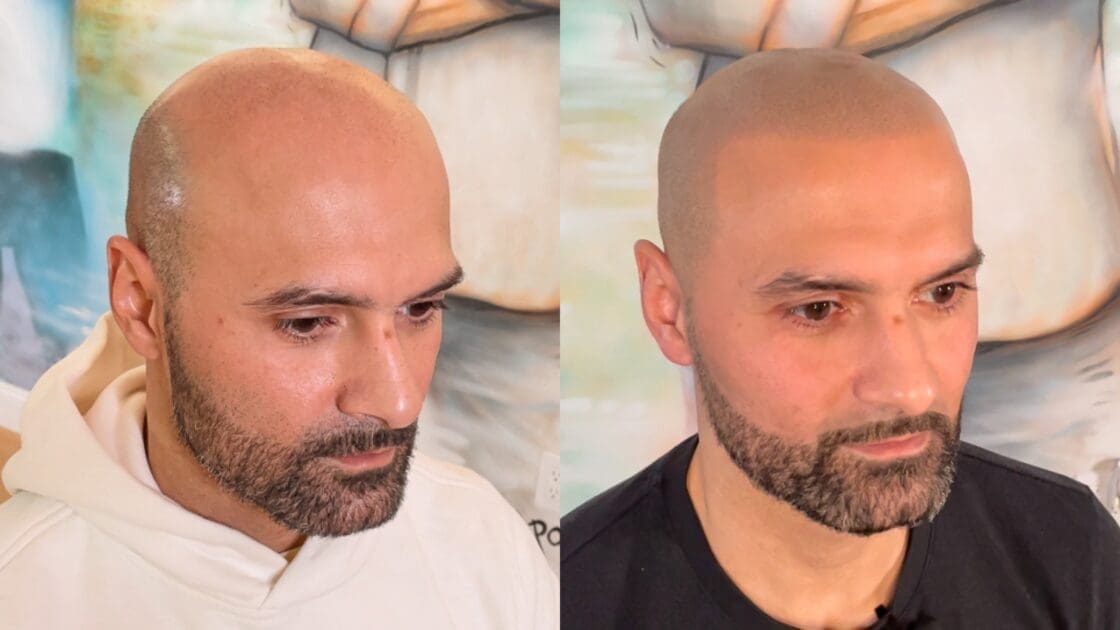What happens to scalp micropigmentation when you get older?

Scalp micropigmentation is an ideal treatment option for those who are looking for an affordable, effective solution for hair loss. Compared to hair transplant surgery, scalp micropigmentation is less invasive and more cost-effective. Plus, it leaves you with a buzzed hairstyle with no scars.
However, many people may be wondering what happens when they get older with scalp micropigmentation. After all, we all start to grey at some point. Fortunately, grey hair doesn’t have an impact on the appearance of scalp micropigmentation.
Continue reading to learn more about what happens with scalp micropigmentation when you get older.
Gray hair and scalp micropigmentation
Most people start to get grey hair around the ages of 40 to 50 years old. For some people, grey hair may appear earlier or later depending on their individual genetics. If you’re getting scalp micropigmentation, you’ll be left with a buzz-cut hairstyle or a close-shaven look. Because it will appear as if the hair follicles are cut close to the scalp, the pigment of grey hair will not be as apparent, especially if the scalp micropigmentation is appropriately maintained. Hair only shows gray as it gets longer.
Those who have gray hair and are balding are still a candidate for scalp micropigmentation. We use a gray-scale pigment that can be adjusted in shade to blend with lighter hair tones. You’ll notice that when your hair is buzzed super short, your follicles are a shade of gray. We simply create a lighter dilution for blending into the existing gray hairs. This is because the pigment tone of the scalp micropigmentation can be personalized to the pigment tone of your current hair. An SMP artist, for example, can add more water to the pigment to lighten the tone before treating your scalp. That way the pigment matches the tone of your natural hair and blends in.
What happens to your scalp micropigmentation when you get older?
Overall, it depends on how you maintain your scalp micropigmentation as you get older. Most SMP specialists recommend maintaining the scalp micropigmentation by keeping the hair trimmed. By trimming the hair two or three times a week, the hair will blend in with any natural hair follicles you may still have on your scalp. When hair is kept short and shaved or trimmed, the hair follicle pigment naturally looks lighter no matter what color your hair is. That’s why it’s important to maintain your scalp micropigmentation long after you initially get the treatment done with a decent pair of trimmers.
A trained scalp micropigmentation specialist can blend lighter pigments in with your natural hair color. Other factors should also be accounted for when getting scalp micropigmentation, such as your level of hair loss and the results you are looking for.
Should you get a touch up?
Many guys may choose to get a touch up as they age. However, you may decide to skip a touch up and instead let the pigment turn lighter over time. Otherwise, lighter pigment can be added and blended on a scalp with hair. A touch up is usually needed after 4 to 6 years. Consult with a scalp pigmentation specialist to determine how a touch up may benefit your scalp micropigmentation results over time.
Get a free consultation
At Scalp Micro USA, experts are available to answer any questions you may have about scalp micropigmentation and how results last over time. Many men who are starting to get grey hair are often the perfect candidates for scalp micropigmentation treatment. Scalp micropigmentation is a versatile treatment option that can be personalized to your look, your hairstyle, and your hair color. With scalp micropigmentation, you can obtain the appearance you want so you can have confidence no matter your age.

Tired of hair loss?
Get the perfect hairline, 100% guaranteed, with our scalp
micropigmentation treatment that is customized just for you. No more
crazy combovers. No more ineffective medications. Just results.